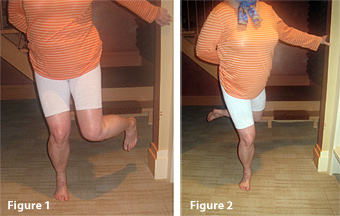It often appears that when the author of a particular test states high accuracy for the test, other scientists down the line, using MRI or other tests, reach opposite conclusions regarding its validity.
At present, one of the most accurate tests for a knee meniscus tear is palpation of localized tenderness at the joint line, which has an accuracy of 89 percent. An MRI is 98 percent accurate. On the other hand, McMurray is only 58 percent accurate. Other tests, such as Steinman I and II, and the Apley compression and distraction test, are also considered less accurate.
Karachalios, et al., state that based on the evaluation of 213 patients with knee injuries, their Thessaly test is 94 percent accurate in the detection of medial meniscus tears and 96 percent accurate for tears of the lateral meniscus compared to MRI testing.2 After testing, slightly more than 3 percent of the subjects with meniscal tears had an increase in pain after the test that required medication. One patient had a locking of the knee that needed to be treated with manipulation under anesthesia to unlock. None of the controls experienced negative responses to the exam.
 The Thessaly test for meniscus tear evaluation involves external or internal rotation of the body with one foot stabilized straight forward and firmly on the ground.
To perform this test, a patient should stand flat-footed with the knee flexed 20 degrees, preferably while holding onto someone or the wall. With one foot stabilized straight forward and the other foot firmly on the ground, the whole body above the knee is either externally or internally rotated (rotation of the femur and the torso in relation to the tibia). See Figures 1 and 2. The test is considered positive when the patient experiences either medial or lateral joint line discomfort or a sense of locking or catching. If the test is positive, it should provoke or reproduce the patient's symptoms.
The Thessaly test for meniscus tear evaluation involves external or internal rotation of the body with one foot stabilized straight forward and firmly on the ground.
To perform this test, a patient should stand flat-footed with the knee flexed 20 degrees, preferably while holding onto someone or the wall. With one foot stabilized straight forward and the other foot firmly on the ground, the whole body above the knee is either externally or internally rotated (rotation of the femur and the torso in relation to the tibia). See Figures 1 and 2. The test is considered positive when the patient experiences either medial or lateral joint line discomfort or a sense of locking or catching. If the test is positive, it should provoke or reproduce the patient's symptoms.
It is necessary to first perform the test on the normal side. Karachalios, et al., feel that pain occurs due to hoop stress at the intact peripheral rim of the torn meniscus (which is innervated) while loading at 20 degrees of flexion, not because of the application of direct pressure on the torn parts of the meniscus (central portion), which have no nerve endings.
In an article currently in press titled "Validation of the Thessaly test for detecting meniscal tears in anterior cruciate deficient knees," Mirzatolooei, et al., found that the Thessaly test had a low specificity in patients with combined ACL and meniscal injuries, and could not be recommended as a diagnostic test in this association.3 The International Academy of Orthopedic Medicine recommends the Thessaly test as the primary test in the clinical examination to confirm a meniscus tear at the knee. It is a simpler test than the McMurray test. Furthermore, the McMurray test can always be applied in instances of a negative Thessaly test.
The problem is that the average age of subjects in the Mirzatolooei study was 28 years, and no acute knee injuries were included. We also do not know whether this test is accurate if the patient has a history of other knee pathology. Without further research, the test may have limits.
References
- Munro W, Healy R. The validity and accuracy of clinical tests used to detect labral pathology of the shoulder: a systematic review. Manual Therapy, 2009;14:119-30.
- Karachalios T, Hantes M, Zibis AH, et al. Diagnostic accuracy of a new clinical test for early detection of meniscal tears. J Bone Joint Surg, 2005;87-A(5):955-62.
- Mirzatolooei F, Yekta Z, Bayazidchi M, et al. Validation of the Thessaly test for detecting meniscal tears in anterior cruciate deficient knees. Knee, 2009 Sept. 12. [Epub ahead of print]
Click here for previous articles by Warren Hammer, MS, DC, DABCO.





